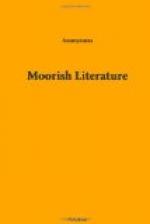But they gave the name of Mauresques to another and different class of romances, of which the heroes are chevaliers, who have nothing of the Mussulman but the name. The talent of certain litterateurs of the sixteenth century exercised itself in that class where the persons are all conventional, or the descriptions are all imaginative, and made a portrait of the Mussulman society so exact that the romances of Esplandian, Amadis de Gaul, and others, which evoked the delicious knight-errantry of Don Quixote, can present a picture of the veritable chivalry of the Middle Ages. We possess but few verses of the Mussulmans of Granada. Argot de Moll preserved them in Arabic, transcribed in Latin characters, one piece being attributed to Mouley Abou Abdallah:
“The charming Alhambra and its palaces
weep
Over their loss, Muley Boabdil (Bon Abdallah),
Bring me my horse and my white buckler,
That I may fight to retake the Alhambra;
Bring me my horse and my buckler blue,
That I may go to fight to retake my children.
“My children are at Guadia, my wife
at Jolfata;
Thou hast caused my ruin, O Setti Omm
el Fata.
My children are at Guadia, my wife at
Jolfata,
Thou hast caused my ruin, O Setti Omm
el Fata!"[6]
[6] A. de Circourt. Histoire des Moors mudijares et des Moresques. Paris, 1846.
As may be seen, these verses have no resemblance to those called Moorish. These are of a purely Spanish diction.[7]
[7] T.A. de Circourt. I. iii., p. 327-332.
Some romances, but not of these last-named, have kept traces of the real legends of the Arabs. There is among them one which treats of the adventures of Don Rodrigues, the last king of the Visigoths—“The Closed House of Toledo."[8] “The Seduction of la Cava,” “The Vengeance of Count Julien,” “The Battle of Guadalete,” are brought back in the same fashion by the historians and writers of Mussulman romances.
[8] R. Basset. Legendes Arabes d’Espagne. La Maison fermee de Tolede. Oran, 1898, in 8vo.
The romance on the construction of the Alhambra has preserved the character of an Arabic legend which dates from before the prophet.[9] There is also a romance on the conquest of Spain, attributed to an Arab writer, the same man whom Cervantes somewhat later feigned to present as the author of Don Quixote, the Moor, Cid Hamet ben Engels.[10]
[9] R. Basset. D’Alhambra et le Chateau de Khanumag: Revue des traditions populaires. Fairier, 1871, p. 459-465.
[10] Histoire des Conquetes d’Espagne par les Mores. Par Ali Aven Sufran. Paris, 1720.




